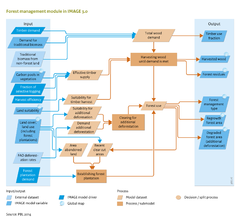Forest management/Data uncertainties limitations: Difference between revisions
Jump to navigation
Jump to search
No edit summary |
No edit summary |
||
| Line 1: | Line 1: | ||
{{ComponentDataUncertaintyAndLimitationsTemplate | {{ComponentDataUncertaintyAndLimitationsTemplate | ||
|Reference=FAO, 2010; IEA, 2012; Brown, 2000; Carle and Holmgren, 2008; UNEP-INTERPOL, 2012; FAO, 2001a; FAO, 2008; | |Reference=FAO, 2010; IEA, 2012; Brown, 2000; Carle and Holmgren, 2008; UNEP-INTERPOL, 2012; FAO, 2001a; FAO, 2008; | ||
|Description=<h2>Data, uncertainties and limitations | |Description=<h2>Data, uncertainties and limitations</h2> | ||
===Data=== | ===Data=== | ||
The main data source for the development and calibration of the forest management module is FAO Forest Resource Assessment ([[FAO, 2010]]), from which data on wood production and deforested areas are derived. In addition, statistics from the International Energy Agency ([[IEA, 2012]]]) are used to estimate the regional fuelwood production, based on household fuelwood and charcoal requirements in national energy statistics. Finally, national data were collected to parameterise the type and production parameters of forest management in world regions (see details in [[Arets et al., 2011]]) and establishment of new forest plantations was designed according to planting rates reported and projected by FAO ([[Brown, 2000]]; [[Carle and Holmgren, 2008]]). | The main data source for the development and calibration of the forest management module is FAO Forest Resource Assessment ([[FAO, 2010]]), from which data on wood production and deforested areas are derived. In addition, statistics from the International Energy Agency ([[IEA, 2012]]]) are used to estimate the regional fuelwood production, based on household fuelwood and charcoal requirements in national energy statistics. Finally, national data were collected to parameterise the type and production parameters of forest management in world regions (see details in [[Arets et al., 2011]]) and establishment of new forest plantations was designed according to planting rates reported and projected by FAO ([[Brown, 2000]]; [[Carle and Holmgren, 2008]]). | ||
| Line 16: | Line 16: | ||
===Limitations=== | ===Limitations=== | ||
The only driver of deforestation modelled in IMAGE 3.0 is the net expansion of agriculture per region. Many drivers of deforestation are not related to agricultural expansion, but there is no global assessment of these other drivers. Therefore, total deforestation rates are calibrated in IMAGE. Drivers and extent of deforestation are very uncertain and subject to debate, yet determine future deforestation and deforestation emissions in scenario simulations. | The only driver of deforestation modelled in IMAGE 3.0 is the net expansion of agriculture per region. Many drivers of deforestation are not related to agricultural expansion, but there is no global assessment of these other drivers. Therefore, total deforestation rates are calibrated in IMAGE. Drivers and extent of deforestation are very uncertain and subject to debate, yet determine future deforestation and deforestation emissions in scenario simulations. | ||
}} | }} | ||
Revision as of 15:29, 21 May 2014
Parts of Forest management/Data uncertainties limitations
| Component is implemented in: |
| Components: |
| Related IMAGE components |
| Projects/Applications |
| Key publications |
| References |
